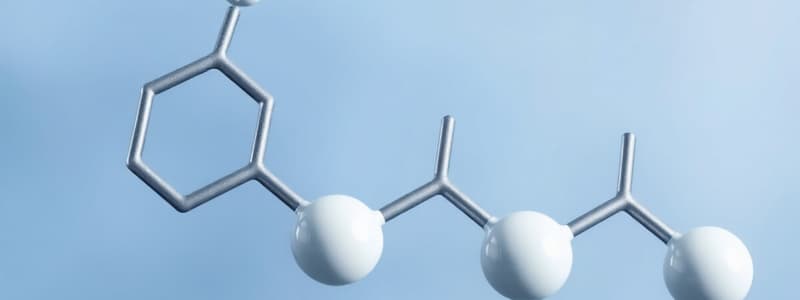Podcast
Questions and Answers
What characterizes alkenes compared to alkanes?
What characterizes alkenes compared to alkanes?
- Alkenes have only C-C and C-H bonds.
- Alkenes are saturated hydrocarbons.
- Alkenes contain at least one C=C double bond. (correct)
- Alkenes have sp3 hybridization.
Which addition reaction is NOT typically associated with alkenes?
Which addition reaction is NOT typically associated with alkenes?
- Hydrogenation (correct)
- Hydration
- Halogenation
- Hydrohalogenation
What is Markovnikov's Rule used for?
What is Markovnikov's Rule used for?
- To explain the behavior of aromatic compounds.
- To understand asymmetrical alkene reactions with HX. (correct)
- To predict the products of hydrogenation reactions.
- To determine the stability of alicyclic compounds.
Which hybridization is associated with alkynes?
Which hybridization is associated with alkynes?
What type of reaction do aromatic compounds typically undergo to maintain resonance stability?
What type of reaction do aromatic compounds typically undergo to maintain resonance stability?
Which of the following best describes the geometry around the double bond in alkenes?
Which of the following best describes the geometry around the double bond in alkenes?
What is a key feature of aromatic compounds according to Huckel's rule?
What is a key feature of aromatic compounds according to Huckel's rule?
Which reaction is typically used to form alkyl halides from alkenes?
Which reaction is typically used to form alkyl halides from alkenes?
What type of hybridization occurs in a molecule with a carbon-carbon triple bond?
What type of hybridization occurs in a molecule with a carbon-carbon triple bond?
Which of the following functional groups is characterized by the presence of a hydroxyl group?
Which of the following functional groups is characterized by the presence of a hydroxyl group?
What is the bond angle in a molecule exhibiting sp3 hybridization?
What is the bond angle in a molecule exhibiting sp3 hybridization?
Which type of bond forms through the sideways overlap of p orbitals?
Which type of bond forms through the sideways overlap of p orbitals?
In IUPAC nomenclature, the suffix for a carboxylic acid is:
In IUPAC nomenclature, the suffix for a carboxylic acid is:
Which of the following compounds represents a ketone?
Which of the following compounds represents a ketone?
Which functional group is classified as a nitrogen-based group and can be primary, secondary, or tertiary?
Which functional group is classified as a nitrogen-based group and can be primary, secondary, or tertiary?
What characteristic enables carbon to form a variety of stable complex structures?
What characteristic enables carbon to form a variety of stable complex structures?
Study Notes
Carbon's Uniqueness
- Carbon’s ability to bond with itself leads to extensive chain and complex structures.
- Carbon possesses four valence electrons, allowing for four covalent bonds.
Atomic Orbitals and Hybridization
- Hybridization is the combination of atomic orbitals to form new hybrid orbitals.
- Sp3 Hybridization: single bonds, tetrahedral shape, 109.5° bond angles (e.g., methane)
- Sp2 Hybridization: double bonds, trigonal planar structure, 120° bond angles (e.g., ethene)
- Sp Hybridization: triple bonds, linear structure, 180° bond angles (e.g., acetylene)
Bonding Types
- Sigma (σ) Bonds: Strong, single bonds formed by head-on orbital overlap.
- Pi (π) Bonds: Formed by sideways overlap of p orbitals; present in double and triple bonds, contributing to reactivity.
Functional Groups
- Specific groups of atoms within molecules that exhibit characteristic properties and reactions.
- Alkyl Groups (R-): Carbon and hydrogen chains.
- Alcohols (-OH): Contain a hydroxyl group.
- Aldehydes (R-CHO): Carbonyl group at the end of a chain.
- Ketones (R-CO-R’): Carbonyl group in the middle of a chain.
- Carboxylic Acids (-COOH): Contain a carboxyl group, giving acidic properties.
- Amines (-NH2): Nitrogen-based groups, classified as primary, secondary, or tertiary.
IUPAC Naming
- Systematic naming of organic molecules based on carbon chain length and functional groups.
- Examples: methane, ethane, and propanol.
Alkanes
- Saturated hydrocarbons with only single bonds, exhibiting sp3 hybridization.
- Primarily undergo substitution reactions with halogens.
Alkenes
- Unsaturated hydrocarbons with at least one C=C double bond, exhibiting sp2 hybridization.
- More reactive than alkanes due to the presence of the π bond.
- Electrophilic Addition Reactions:
- Hydrohalogenation: Addition of hydrogen halides (e.g., HCl, HBr) to form alkyl halides.
- Hydration: Addition of water (H2O) to form alcohols.
- Halogenation: Addition of halogens (e.g., Br2, Cl2) to form dihalides.
- Markovnikov's Rule: When asymmetrical alkenes react with HX, the hydrogen attaches to the carbon with more hydrogen atoms.
Alkynes
- Hydrocarbons containing at least one C≡C triple bond, exhibiting sp hybridization.
- Highly reactive due to the high-energy π bonds.
- Undergo addition reactions, often producing trans products.
- Hydrogenation: Can be reduced to alkenes or alkanes using catalysts like Pd or Lindlar’s catalyst.
Aromatic Compounds (Arenes)
- Cyclic organic compounds with conjugated double bonds.
- Exhibit resonance stability, resulting in delocalized π electrons.
- Aromaticity: Follows Huckel’s rule, requiring a (4n + 2) π electron configuration.
- Electrophilic Aromatic Substitution: Benzene and other aromatics undergo these reactions, substituting a hydrogen atom with an electrophile.
- Nitration: Reaction with nitric acid to form nitrobenzene.
- Halogenation: Reaction with halogens (Cl2, Br2) in the presence of a catalyst.
Studying That Suits You
Use AI to generate personalized quizzes and flashcards to suit your learning preferences.
Description
Explore the unique properties of carbon and its ability to form complex structures through various hybridizations. This quiz covers the types of bonds, including sigma and pi bonds, and introduces essential functional groups. Test your knowledge on how carbon compounds connect and react in organic chemistry.




